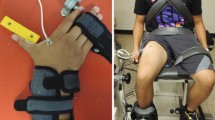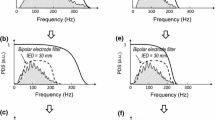Abstract
The purpose of the present study was to determine the specific changes occurring in the power spectrum with an increasing force level during isometric contractions. Surface electromyographic signals of the triceps brachii (TB) and the anconeus (AN) of 29 normal subjects were recorded during isometric ramp contractions performed from 0 to 100% of the maximum voluntary contraction (MVC) in a 5-s period. Power spectra were obtained at 10, 20, 30, 40, 50, 60, 70, 80 and 90% MVC. Changes in the shape of these spectra were evaluated visually and with the calculation of several statistical parameters related to the distribution of power along the frequency axis, such as median frequency and mean power frequency, standard deviation, skewness, first and third quartiles and half-power range. For the AN, the behaviour of the spectrum was relatively similar across subjects, presenting a shift toward higher frequencies without any major change in the shape of the spectrum. For the TB, subjects with a thin skinfold thickness presented similar behaviours. In subjects with a thicker skinfold, however, a loss of power in the high frequency region paralleled the increase in the force level. Significant correlations were obtained between the extent of the change in the value of higher order statistical parameters across force and the thickness of the skin. This points out the importance of the skinfold layer when recording with surface electrodes. Furthermore, the use of a combination of several parameters appears to provide a better appreciation of the changes occurring in the spectrum than any single parameter taken alone.
Similar content being viewed by others
References
Basmajian JV, De Luca CJ (1985) Muscles alive. Their functions revealed by electromyography, 5th ed. Williams and Wilkins, Baltimore
Bilodeau M, Arsenault AB, Gravel D, Bourbonnais D (1990) The influence of an increase in the level of force on the EMG power spectrum of elbow extensors. Eur J Appl Physiol 61:461–466
Bilodeau M, Arsenault AB, Gravel D, Bourbonnais D (1991) EMG power spectra of elbow extensors during ramp and step isometric contractions. Eur J Appl Physiol 63:24–28
Bilodeau M, Arsenault AB, Gravel D, Bourbonnais D (1992a) Influence of gender on the EMG power spectrum during an increasing force level. J Electromyogr Kinesiol 2:121–129
Bilodeau M, Arsenault AB, Gravel D, Bourbonnais D (1992b) Time and frequency analysis of EMG signals of homologous elbow flexors and extensors. Med Biol Eng Comput 30:640–644
Bilodeau M, Arsenault AB, Gravel D, Bourbonnais D, Lepage Y, Harel F (1992c) The influence of authropometric factors on the EMG power spectrum of upper limb muscles. Proceedings, 9th International Congress of the International Society for Electrophysiological Kinesiology, Florence, Italy, p 40
Bilodeau M, de la Barrera EJ, Arsenault AB, Gravel D, Bourbonnais D, Kemp F (1993) Stationarity of EMG signals obtained across increasing force levels during ramp and step contractions. J Biomech 26:09
Brooke MH, Engel WK (1969) The histographic analysis of human muscle biopsies with regard to fibre types. 1. Adult male and female. Neurology 19:221–233
Duxbury AJ, Hughes DF, Clark DE (1976) Power spectral distribution of the masseter electromyogram from surface electrodes. J Oral Rehabil 3:333–339
Gander RE, Hudgins BS (1985) Power spectral density of the surface myoelectric signal of the biceps brachii as a function of static load. Electromyogr Clin Neurophysiol 25:469–478
Gerdle B, Wretling M-L, Henriksson-Larsen K (1988) Do the fibre type proportion and the angular velocity influence the mean power frequency of the electromyogram? Acta Physiol Scand 134:341–346
Gerdle B, Henriksson-Larsen K, Lorentzen R, Wretling M-L (1991) Dependence of the mean power frequency of the electromyogram on muscle force and fibre type. Acta Physiol Scand 142:457–465
Hagberg M, Ericson B-E (1982) Myoelectric power spectrum dependence on muscular contraction level of elbow flexors. Eur J Appl Physiol 48:147–156
Hagg GM (1991) Comparison of different estimators of electromyographic spectral shifts during work when applied on short test contractions. Med Biol Eng Comput 29:511–516
Hary D, Belman MJ, Propst J, Lewis S (1982) A statistical analysis of the spectral moments used in EMG tests of endurance. J Appl Physiol 53:779–783
Knaflitz M, Merletti R, De Luca CJ (1990) Inference of motor unit recruitment order in voluntary and electrically elicited contractions. Appl Physiol 68:1657–1667
Knutsson E, Martensson A (1980) Dynamic motor capacity in spastic paresis and its relation to prime mover dysfunction, spastic reflexes and antagonist coactivation. Scand J Rehabil Med 12:93–106
Komi PV, Viitasalo JT (1976) Signal characteristics of EMG at different levels of muscle tension. Acta Physiol Scand 96:267–276
Latash ML (1988) Spectral analysis of the electromyogram (EMG) in spinal cord trauma patients I. Different types of the EMG and corresponding spectra. Electromyogr Clin Neurophysiol 28:319–327
Lindström L, Petersén I (1983) Power spectrum analysis of EMG signals and its application. In: Desmedt JE (ed) Progress in clinical neurophysiology, vol 10. Karger, Basel, pp 1–51
Masuda T, De Luca CJ (1991) Recruitment threshold and muscle fibre conduction velocity of single motor units. J Electromyogr Kinesiol 1:116–123
Merletti R, La Conte LR, Cisari C, Actis MV (1992) Age related changes in surface myoelectric signals. Scand J Rehabil Med 24:25–36
Moglia A, Bejor M, Cattaneo S, Lottici P, Zandrini C, Arrigo A (1987) Surface EMG evaluation of quadriceps femoris in normal and spastic subjects. Electromyogr Clin Neurophysiol 27:217–222
Moglia A, Alfonsi E, Zandrini C, Ciano C, Rascaroli M, Toffola ED, Arrigo A (1991) Surface EMG analysis of rectus femoris in patients with spastic hemiparesis undergoing rehabilitation treatment. Electromyogr Clin Neurophysiol 31:123–128
Moritani T, Muro M (1987) Motor unit activity and surface electromyogram power spectrum during increasing force of contraction. Eur J Appl Physiol 56:260–265
Moritani T, Gaffney FD, Carmichael T, Hargis J (1985) Interrelationships among muscle fibre types, electromyogram, and blood pressure during fatiguing isometric contraction. In: Winter DA, Norman RW, Wells RP, Hayes KC, Patla AE (eds) Biomechanics IX-A. Human Kinetics Champaign, pp 287–292
Roy SH, De Luca CJ Schneider J (1986) Effects of electrode location on myoelectric conduction velocity and median frequency estimates. J Appl Physiol 61:1510–1517
Sanchez J, Solomonow M, Baratta RV, D'Ambrosia R (1992) EMG power spectra frequencies profiles of elbow antagonist muscle pair during linearly and stepwise increasing contractions. Proceedings of the 9th International Congress of the International Society for Electrophysiological Kinesiology, Florence, Italy, p 63
Sato H (1982) Functional characteristics of human skeletal muscle revealed by spectral analysis of the surface electromyogram. Electromyogr Clin Neurophysiol 22:459–516
Simoneau JA, Bouchard C (1989) Human variation in skeletal muscle fibre-type proportion and enzyme activities. Am J Physiol 257:E567-E572
Simoneau JA, Lortie G, Boulay MR, Thibault M-C, Thériault G, Bouchard C (1985) Skeletal muscle histochemical and biochemical characteristics in sedentary male and female subjects. Can J Physiol Pharmacol 63:30–35
Solomonow M, Baten C, Smit J, Baratta R, Hermens H, D'Ambrosia R, Shoji H (1990) Electromyogram power spectra frequencies associated with motor unit recruitment strategies. J Appl Physiol 68:1177–1185
Stulen FB, De Luca C (1981) Frequency parameters of the myoelectric signal as a measure of conduction velocity. IEEE Trans Biomed Eng 28:515–523
Sypert GW, Munson JB (1981) Basis of segmental motor control:motoneuron size or motor unit type? Neurosurgery 8:608–621
Viitasalo JT, Komi PV (1978) Interrelationships of EMG signal characteristics at different levels of muscle tension and during fatigue. Electromyogr Clin Neurophysiol 18:167–178
Wretling ML, Gerdle B, Henriksson-Larsen K (1987) EMG: a noninvasive method for determination of fibre type proportion. Acta Physiol Scand 131:627–628
Author information
Authors and Affiliations
Rights and permissions
About this article
Cite this article
Bilodeau, M., Cincera, M., Gervais, S. et al. Changes in the electromyographic spectrum power distribution caused by a progressive increase in the force level. Europ. J. Appl. Physiol. 71, 113–123 (1995). https://doi.org/10.1007/BF00854967
Accepted:
Issue Date:
DOI: https://doi.org/10.1007/BF00854967




